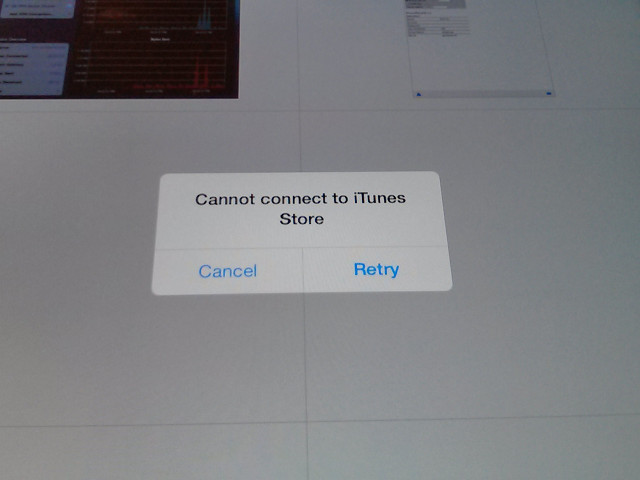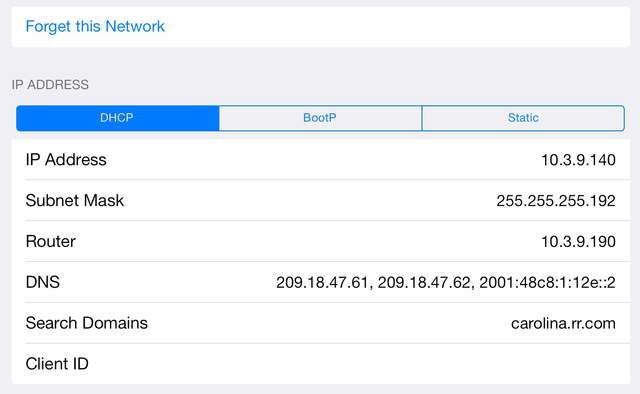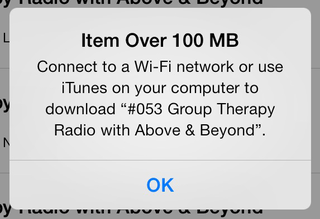
 |
| News | Profile | Code | Photography | Looking Glass | Projects | System Statistics | Uncategorized |
Blog |
Yes, I have a few things to say about this. It's not a review of the iPad Air but more of a whiny rant (shocker, I know).
I recently picked up an iPad Air MF018LL/A, which is the white cellular model with 128 GiB of storage. I use AT&T for carrier diversity with the 3 GiB/mo plan since my phone is on T-Mobile's network. The iPad Air replaced my iPad 3, which when I owned it was jailbroken and still running iOS 6. I happened to sell it and all of my accessories to a colleague who is now a first-time iPad owner.
Below: iPad 3 on the left, iPad Air on the right.
My first impression with the iPad Air was awful since it failed at the first thing I asked it to do: install an application. I got the dreaded "could not connect to iTunes store" error whenever I tried to install an application on Wi-Fi or cellular.

It turns out this is an iOS 7 issue that some folks got after upgrading from iOS 6 and there was a thread on the Apple Support Communities site about it. I had to ultimately do a factory reset and wipe of the device to fix it. I didn't lose anything because it was a brand new iPad and I had not loaded anything back onto it. It's odd that this hasn't been fixed in iOS 7.0.3, which is what's running on my iPad Air. I also wonder how iOS 7 was loaded onto the iPad. I'm almost wondering if iOS 6 was initially running on the iPad Air during development and the first few devices were shipped with a version of iOS 7 that was upgraded from an existing iOS 6 installation. Curious.
The iPad Air hardware is good. The CPU seems fast (Google Earth is smooth as butter) and the shell (+ components) is much lighter and thinner than the iPad 3. I'm not sure what I think about battery life, yet. So far, it seems to last slightly less than my iPad 3 but my analysis is most unscientific.
The antennas or cellular radio itself must be better in the iPad Air vs. the iPad 3 because I have five "dots" more often than I had five "bars" on the iPad 3. I suppose the "dots" could be mapped to different ranges of dBm in iOS 7, now, or the addition of more LTE bands is helping, although I didn't think LTE bands themselves overlapped within an area.
I configured the switch on the side of the iPad Air to control roation lock, since I have volume muted almost all of the time, anyway. I find that, compared to the iPad 3, it's more difficult to slide the button back & forth with my finger. The button itself appears to be rounded and the one on the iPad 3 had sharper edges that were easier to "grab" with my finger.
I'm disappointed that the fingerprint reader now being used on the iPhone 5s didn't make its way into the iPad Air. I guess it doesn't matter to me since I probably wouldn't have used it, anyway.
I don't mind the visual changes in iOS 7, to be honest. I thought the skeuomorphisms probably needed to go, too. There are a few things that bug me, though.
The control center is an abomination. Apple made the decision on what toggles should be available to users and didn't leave any room for customization. It's infuriating. I would like to swap out the airplane mode for a toggle that turns cellular data on and off. If I'm connected to Wi-Fi and want to shut off cellular data to save a little bit of battery life, I have to navigate all of the way to settings.
It appears the text size for items on the status bar at the top of the screen has become smaller. The text size setting doesn't appear to change the font size of them. What's weird is the items are larger at the lock screen but shrink when the device is unlocked. Very odd.
The IPv6 support seems better than in previous versions of iOS. I didn't have a problem loading all web pages over IPv6 on my dual-stack network at home. In iOS 6, some of those pages would have loaded over IPv4 due to Apple's odd HE implementation. DHCPv6 appeared to work on one of my test SSIDs but unfortunately the iPad put the IPv4 DNS servers before the IPv6 one. More testing is required, apparently.

One difference in the IPv6 support between iOS 6 and 7 is the implementation of RFC 4941 when SLAAC is used. iOS 6 added temporary addresses with random interface identifiers but always kept the link-local address based on EUI-64 as well as one GUA. iOS 7 appears to randomize the interface identifiers for both the link-local address and all the GUAs. I really wish it was possible to disable this.
I really miss the jailbroken functionality I had with iOS 6 on my iPad 3. Lots of people ask me why I bother to still jailbreak iOS devices—my reasons mostly relate to optimization and performance. I'll detail them all here.
3G Unrestrictor. This application works around some of the very annoying and pointless restrictions of iOS itself and many applications. Podcasts, iTunes, and the App Store won't download anything over 100 MB (I assume MiB) over a cellular connection.

There's no way to disable this and it's infuriating. TWC TV won't stream live TV over cellular. The list goes on. These restrictions are stupid because iOS and the various applications are essentially telling the user that they're too stupid and irresponsible to use their cellular data plan. If I want to burn up my plan downloading podcasts that is my prerogative! 3G Unrestrictor fixes all of these issues and fools applications into thinking the current network connectivity is via Wi-Fi.
SBSettings. SBSettings provides functionality similar to iOS' control center but is instead customizable and provides tweaks that allow various things on the status bar to be changed. Toggles include data, OpenVPN (if installed), 3G Unrestrictor, and more. The status bar can be configured to show the current Wi-Fi SSID, numeric signal strength indicators for both cellular and Wi-Fi, non-scaled battery percentage, and more other options than I can remember at the moment.
FakeClockUp. This application speeds up transitions and some animations on iOS. Although these animations take only a second or so every time, this can add up to minutes and hours of wasted time over the life of a device. This application is needed because iOS doesn't provide an option to disable these transitions.
Command-line Access. While most non-geeks do not care about such things, command-line access provides a wealth of flexibility. Among other things, it allows for network-related diagnostics and troubleshooting as well as the ability to directly back up media and application data that is otherwise inaccessible or only provided by other 3rd party applications.
Hopefully, the above will be usable for iPad Air owners once again when the iOS 7 jailbreak is released. Until then, we're locked into doing things the way Apple wants us to do them, sans-choice.
New comments are currently disabled for this entry.
     |
This HTML for this page was generated in 0.001 seconds. |